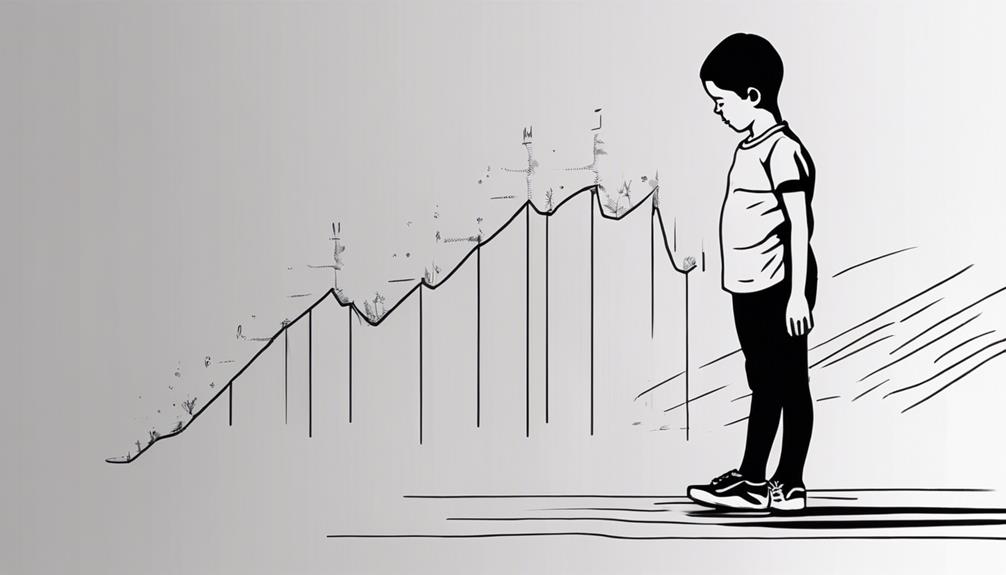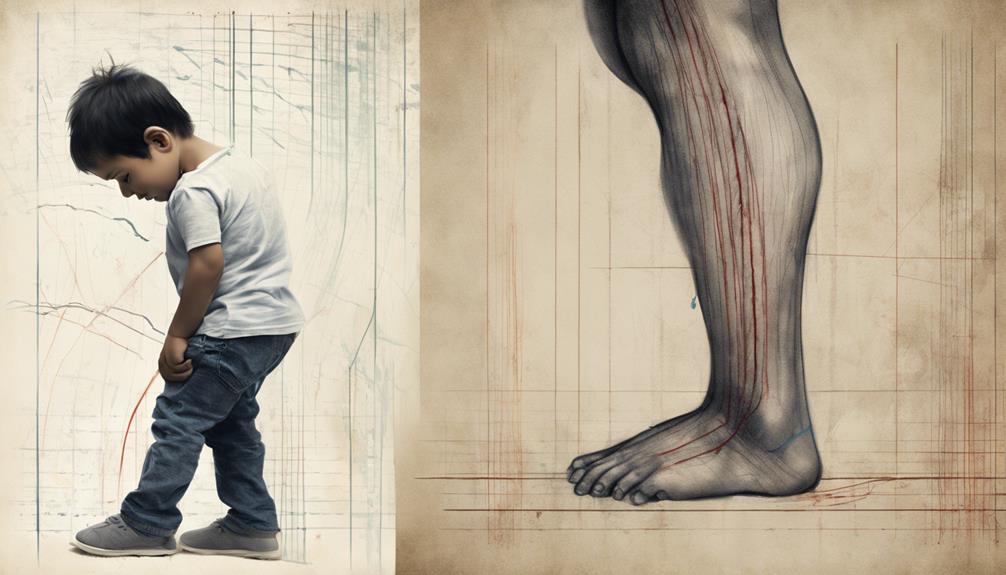Growing pains, a common concern among parents, often present as discomfort or soreness in children's limbs, notably the legs. While these pains are generally benign and temporary, their exact cause remains somewhat elusive. Understanding the mechanisms triggering this phenomenon can shed light on strategies to manage and alleviate the associated discomfort. Delving into the complexities of growing pains can provide valuable insights into how best to support children experiencing these episodes and when to seek further medical evaluation.
Key Takeaways
- Growing pains are common in children aged 3 to 12 and present as aching or cramping sensations in the legs.
- They are influenced by physical activity levels, joint flexibility, and possibly muscle fatigue, not directly correlated with growth spurts.
- Diagnosis relies on symptom manifestation and physical assessment, typically not requiring extensive tests like blood work or imaging studies.
- Supportive measures include warm baths, stretching exercises, pain management with medications, and lifestyle adjustments for well-being improvements.
Understanding Growing Pains

Growing pains, a common phenomenon experienced by children aged 3 to 12, present as aching or cramping sensations primarily in the legs during late afternoon or evening. While these pains are not directly linked to growth spurts, they can be influenced by factors such as physical activity levels, joint flexibility, and vitamin D status. The exact cause of growing pains remains unclear, with theories suggesting they may stem from overuse of muscles, bone growth, or a child's developing nervous system. However, growing pains are generally considered a normal part of childhood and are not indicative of any serious underlying condition.
When a child experiences leg pain that fits the typical pattern of growing pains, such as bilateral leg involvement and absence of joint swelling or redness, a healthcare provider can often diagnose the condition based on the reported symptoms and a physical examination. Specific blood tests or X-rays are usually unnecessary unless there are atypical features or concerning signs present. Management of growing pains typically involves reassurance, comfort measures like gentle massages, warm baths, and appropriate pain relief as advised by a healthcare professional.
Common Symptoms in Children
Common symptoms of growing pains in children often include aching or throbbing sensations in the legs, particularly in areas like the thighs, calves, or behind the knees. The pain typically affects both legs and may be intermittent in nature. Some children may also report accompanying complaints such as abdominal pain or headaches during episodes of growing pains.
Signs in Kids
During episodes of growing pains in children, they may experience aching or throbbing sensations in various areas of their legs. The pain commonly occurs in the thighs, calves, or behind the knees and typically affects both legs simultaneously. These pains can be intermittent, appearing and disappearing over time. In some instances, children might also report abdominal discomfort or headaches during episodes of growing pains. It is important for parents and caregivers to recognize these signs in kids to differentiate between growing pains and other potential health issues. The table below summarizes the common symptoms seen in children experiencing growing pains.
| Symptoms | Description |
|---|---|
| Aching or throbbing sensations | Felt in legs during episodes |
| Pain locations | Thighs, calves, behind the knees |
| Intermittent nature | Comes and goes over time |
| Associated symptoms | Abdominal discomfort, headaches |
Physical Discomforts
Episodes of physical discomfort in children, particularly characterized by aching or throbbing sensations in the legs, are commonly associated with growing pains. These pains in a child's legs can be distressing, but it's important to note that they are usually harmless and temporary. To provide a better understanding of this phenomenon, consider the following:
- Location: The pains are often felt in the thighs, calves, or behind the knees.
- Episodic Nature: They can come and go in episodes, rather than persisting continuously.
- Additional Symptoms: Sometimes, growing pains may be accompanied by abdominal discomfort or headaches.
Understanding these aspects can help caregivers differentiate growing pains from potentially more serious issues, providing reassurance during these uncomfortable episodes.
The Causes Behind Growing Pains
Growing pains, a common childhood complaint, are believed to be possibly triggered by muscle fatigue stemming from physical activities such as running and jumping, rather than directly correlated with growth spurts. While the exact cause of growing pains is not completely understood, research suggests a potential link between lower pain thresholds in children and the onset of growing pains. Additionally, joint hypermobility syndrome has been identified as a potential factor contributing to musculoskeletal discomfort experienced during growing pains. Furthermore, vitamin D deficiency has also been considered as a possible influence on the development of growing pains in children.
It is important to note that growing pains typically affect both legs and are commonly reported in the evening or at night. Despite the discomfort they bring, growing pains do not cause any long-term damage to bones or muscles. By understanding the various factors that may contribute to growing pains, healthcare providers can better address and manage this common childhood ailment.
Diagnosis of Growing Pains
As the evaluation of growing pains primarily relies on symptom manifestation and physical assessment, the diagnosis of this common childhood complaint typically does not necessitate additional investigative measures such as blood work or imaging studies. When considering the diagnosis of growing pains, the following points are essential for understanding:
- Symptoms of Growing Pains: The key to diagnosing growing pains lies in recognizing the typical symptoms experienced by children, such as bilateral leg discomfort during late afternoon or evenings.
- Causes of Growing Pains: Understanding that growing pains are idiopathic, meaning their exact cause is unknown, helps in differentiating them from other conditions causing leg pain.
- Diagnosing Growing Pains: Consulting a healthcare provider is crucial to rule out other potential causes of leg pain and to confirm a diagnosis of growing pains. Keeping a symptom diary can assist in tracking patterns and aiding in the accurate diagnosis of growing pains.
Managing Growing Pains

In managing growing pains, addressing physical discomfort through comfort measures like warm baths and massages, along with incorporating stretching exercises, is essential for relief. Additionally, ensuring proper footwear and support for the child's feet can play a crucial role in effectively managing growing pains. Alongside these measures, the use of over-the-counter pain relievers under healthcare provider guidance and encouraging regular physical activity can help reduce the frequency and intensity of growing pains in children.
Addressing Physical Discomfort
Addressing physical discomfort associated with growing pains entails implementing a range of practical measures to alleviate the discomfort and improve overall well-being. To manage growing pains effectively, consider the following:
- Utilize heating pads or warm baths to soothe the muscles and provide relief.
- Engage in gentle stretching exercises to enhance flexibility and reduce stiffness in the joints.
- Consult with a healthcare provider about using over-the-counter pain relievers for targeted pain management.
Supportive Measures for Relief
Supportive measures play a crucial role in effectively managing growing pains, providing relief through targeted interventions and strategies. Utilizing a heating pad or warm baths can help alleviate discomfort, while gentle massages on the affected areas may reduce the aching or throbbing sensations commonly associated with growing pains. Additionally, encouraging children to engage in gentle stretching exercises could potentially decrease both the intensity and frequency of these pains. Moreover, under the guidance of a healthcare provider, over-the-counter pain relievers like acetaminophen or ibuprofen may be used. Ensuring proper footwear and support, such as orthotics for those with flat feet, can also aid in minimizing the impact of growing pains on daily activities.
| Supportive Measures | Description | Benefits |
|---|---|---|
| Warm Bath | Using warm baths to alleviate discomfort | Provides relaxation and pain relief |
| Massage | Gentle massaging of affected areas | Helps reduce aching sensations |
| Stretching Exercises | Encouraging gentle stretching routines | May decrease intensity and frequency |
Seeking Medical Advice
When growing pains persist or significantly impact daily activities, seeking medical advice is imperative. It is essential to consult a healthcare provider if a child experiences prolonged or severe growing pains to rule out underlying conditions. Here are three crucial reasons why seeking medical advice is necessary:
- Proper Diagnosis: Medical professionals can differentiate between growing pains and other potential causes of discomfort, ensuring appropriate treatment.
- Monitoring: Regular check-ups allow for monitoring the child's growth and pain patterns, ensuring early detection of any concerning developments.
- Potential Interventions: Healthcare providers can suggest pain management strategies or recommend further investigations if needed, providing relief and peace of mind for both the child and caregivers.
Given the potential impact on a child's well-being, seeking medical advice when growing pains raise concerns is a proactive step towards ensuring their health and comfort.
Frequently Asked Questions
Do Growing Pains Mean Growth Spurt?
Growing pains are not indicative of a growth spurt. They are typically characterized by muscle soreness in children aged 3 to 12 and are unrelated to actual bone growth or physical activity. These pains do not signify an increase in height or accelerated growth. Instead, they are musculoskeletal discomforts that occur independently of growth spurts. Thus, experiencing growing pains does not necessarily equate to undergoing a growth spurt or heightened bone development.
Can I Get Growing Pains at 16?
At the age of 16, experiencing growing pains is less common due to the typical window for their occurrence passing by this age. Factors such as intense physical activity, injuries, or medical conditions are more likely causes of leg pain at 16. While muscle aches can still be present, they are less likely to be classified as growing pains. Consulting a healthcare professional is advisable to determine the underlying cause of leg pain in adolescents at this age.
What Can Be Mistaken for Growing Pains?
Muscle strain, injury, restless leg syndrome, and arthritis are conditions that can be mistaken for growing pains. In children, these symptoms may be misinterpreted due to their commonality with growing pains. However, proper evaluation by a healthcare provider is crucial to differentiate between these conditions and growing pains. In some cases, juvenile idiopathic arthritis, fractures, tendonitis, bone infections, rheumatoid arthritis, lupus, Lyme disease, leukemia, and bone tumors can mimic the symptoms of growing pains.
What Are Growing Pains in Adults?
In adults, leg pain attributed to growing pains is not a recognized medical phenomenon. However, muscle strain, stress fractures, and overuse injuries can lead to similar symptoms. It is essential to differentiate between these conditions and seek medical evaluation for accurate diagnosis and appropriate treatment. Leg pain in adults may be indicative of underlying issues such as nerve compression, arthritis, or circulatory problems, emphasizing the importance of professional assessment for effective management.
Conclusion
In conclusion, growing pains are a common occurrence in children, typically manifesting as cramping or aching in the limbs, especially the legs. While discomfort can be managed with comfort measures, persistent or severe pain warrants medical attention. One may argue that growing pains are simply a part of childhood development and do not require intervention. However, it is crucial to address any pain that interferes with daily activities to ensure the well-being of the child.
